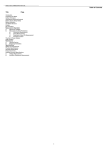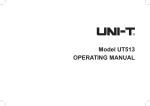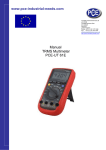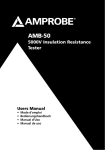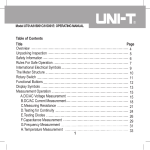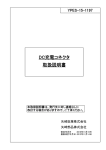Download UNI-T UT502 Specifications
Transcript
UT501/UT502 OPERATING MANUAL Table of Contents Title Page Introduction 4 Unpacking the Meter 4 Safety Information 6 International Electrical Symbols 11 The Meter Structure 12 Key Functions 14 Rotary Switch 15 Measurement Operation 16 A. Measuring Voltages 16 B. Measuring Insulation Resistance 18 1 UT501/UT502 OPERATING MANUAL Maintenance 21 A. General Service 21 B. Replacing the Battery 23 Specifications 25 Safety and Compliances 25 Physical Specifications 26 General Specifications 27 Feature Summary 27 Detailed Accuracy Specifications 28 A. Voltage Measurement 28 B. UT501: Insulation Resistance Measurement 29 UT502: Insulation Resistance Measurement 30 2 UT501/UT502 OPERATING MANUAL List of Tables Table Title 1. Unpacking Inspection Page 5 2. International Electrical Symbols 11 3. Meter Front Description 13 4. Key Description 14 5. Rotary Switch Description 15 List of Figures Figure Title Page 1. The Meter Front Structure 12 2. Voltages Measurement 16 3. Insulation Resistance Measurement 18 4. Battery Replacement 23 3 UT501/UT502 OPERATING MANUAL Introduction Uni-Trend Model UT501 and UT502 insulation resistance tester (hereafter, "the Meter") is a handheld instrument designed primarily to make resistance/ insulation resistance, DC/AC Voltage measurement. Unpacking the Meter The Meter includes the following items: 4 UT501/UT502 OPERATING MANUAL Table 1. Unpacking Inspection Item Description Qty 1 English Operating Manual 1 piece 2 Test Lead 1 set 3 Test probe 1 set 4 Alligator clip 1 set 5 Carry bag 1 piece 6 Strap 1 piece 5 1.5V Battery (LR14) 6 pieces In the event you find any missing or damage, please contact your dealer immediately. 5 UT501/UT502 OPERATING MANUAL Safety Information This Meter complies with the standards IEC61010 -1 safety measurement requirement: in pollution degree 2, overvoltage category (CAT. III 600V, CAT.II 1000V) and double insulation. CAT II: Local level, appliance, portable equipment etc., with smaller transient voltage overvoltages than CAT. III CAT III: Distribution level, fixed installation, with smaller transient over voltages than CAT. IV Use the Meter only as specified in this operating manual, otherwise the protection provided by the Meter may be impaired. 6 UT501/UT502 OPERATING MANUAL Danger identifies conditions and actions that pose hazard(s) to the user. Warning identifies avoiding electric shock. Caution identifies conditions and actions that may damage the Meter and carrying out accurate measurement. International electrical symbols used on the Meter and in this Operating Manual are explained on page 11. 7 UT501/UT502 OPERATING MANUAL Danger Use of instrument in a manual not specifed by the manufactuer may impair safety features/protection provided by the equipment. Read the following safety information carefully before using or servicing the instrument. Do not apply more than 1000V DC or 750V AC. Do not use the Meter around explosive gas, vapor or dust. Do not use the Meter in a wet environment. When using the test leads, keep your figures away from the lead contacts. Keep your figures behind the finger guards on the leads. Do not use the Meter with any parts or cover removed. When carrying out insulation measurement, do not contact the circuit under test. 8 UT501/UT502 OPERATING MANUAL Warning Do not use the Meter if it is damaged or metal part is exposed. Look for cracks or missing plastic. Be careful when working above 30V rms, 46.7V ac rms and 70V DC. Such voltages pose a shock hazard. Do not change battery when the Meter is in wet environment. Place test leads in proper input terminals. Make sure all the test leads are firmly connected to the Meterís input terminals. Make sure the Meter is turned off when opening the battery compartment. Carefully read the operating manual before operating the Meter. Follow the operating manual all the time when using the Meter and keep the operating manual in a safe place. Wrong operation will cause incident and damage to the Meter. 9 UT501/UT502 OPERATING MANUAL Caution When performing resistance tests, remove all power from the circuit to be measured and discharge all the power. When servicing the Meter, use only the same model number or identical electrical specifications of test leads and power adaptor. Do not use the Meter if the battery indicator ( ) shows a battery empty condition. Take the battery out from the Meter if it is not used for a long time. Do not use or store the Meter in an environment of high temperature, humidity, explosive, inflammable and strong magnetic field. The performance of the Meter may deteriorate after dampened. 10 UT501/UT502 OPERATING MANUAL International Electrical Symbols International symbols on the Meter and in this manual are explained in Table 2. Table 2. International Electrical Symbols DCV ACV Equipment protected by double or reinforced insulation. DC Measurement AC Measurement Grounding See Manual Conforms to Standards of European Union 11 UT501/UT502 OPERATING MANUAL The Meter Structure Below Figure 1 and Table 3 shows the Meter front structure and description. a.UT501 b.UT502 Figure 1. The Meter Front Structure 12 UT501/UT502 OPERATING MANUAL Table 3. Meter Front Description 1 EARTH: Resistance input terminal 2 G: Voltage Measurement input negative terminal 3 V: Voltage input terminal 4 LINE: Resistance input terminal 5 LCD 6 Display Backlight button 7 Data Hold button 8 Insulation Resistance Button 9 Rotary switch 13 UT501/UT502 OPERATING MANUAL Key Functions Table 4. Key Description HOLD Press once to turn the data hold on, is shown on the display. Press again to turn the data hold feature off. is disappeared. LIGHT Press once to turn the display backlight on. Press again to turn the display backlight off. TEST Press to stop or start an insulation resistance test. 14 UT501/UT502 OPERATING MANUAL Rotary Switch Table 5. Rotary Switch Description ON/OFF Turn on or off the Meter. ACV Turn the rotary switch to ACV to measure AC Voltage DCV Turn the rotary switch to DCV to measure DC Voltage 250V/500V/1000V Turn the rotary switch to 250V/500V/1000V, select the (UT501 ) requested output voltage, to carry out insulation resistance measurement. 500V/1000V/2500V Turn the rotary switch to 500V/1000V/2500V, select (UT502 ) the requested output voltage, to carry out insulation resistance measurement. 15 UT501/UT502 OPERATING MANUAL Measurement Operation Below section explains how to make measurements. A. Measuring Voltages a.UT501 b.UT502 Figure 2. Voltages Measurement 16 UT501/UT502 OPERATING MANUAL Catuion To avoid harm to you or damages to the Meter from electric shock, do not attemptto meaure voltages higher than 1000V DC or 750V rms AC although readings may be obtained. When voltage measurement has been completed, disconnect the connection between the testing leads and the circuit under test and remove testing leads away from the input terminals of the Meter. Do not carry out measurement when the battery compartment is open. To measure voltages, set up the Meter as Figure 4 and do the following: 1. Turn the rotary switch to DCV or ACV. 2. Insert the red test lead into the V terminal and the black test lead into the G terminal. Then carry out the measurement. 17 UT501/UT502 OPERATING MANUAL B. Measuring Insulation Resistance a.UT501 b.UT502 Figure 3. Insulation Resistance Measurement 18 UT501/UT502 OPERATING MANUAL Caution When measuring insulation resistance, please must separate the two test leads. When performing insulation resistance tests, remove all power from the circuit to be measured and discharge all the power. Do not short circuit two test leads under high voltage status. Do not measure insulation resistance after high voltage output. Do not carry out measurement when the battery compartment is open. When the measurement is completed, donít touch the circuit as the circuit has already stored capacitance, which may cause electric shock. Don't touch the test leads even after it has been removed from the circuit until voltages are all released. Do not carry out measurement when the battery compartment is open. To measure insulation resistance, set up the Meter as Figure 3 and do the following: 19 UT501/UT502 OPERATING MANUAL Turn the rotary switch to one of these position 250V / 500V / 1000V / 2500V. 1. When performing insulation resistance tests, remove all power from the circuit to be measured and discharge all the power. 2. Insert the red test lead into the LINE terminal and the black test lead into EARTH terminal. 3. Connect the red and black alligator clip to the circuit to be measured, positive voltage output from LINE terminal. Continuous Measurement 1. Turn the rotary switch to one of these position 250V / 500V / 1000V / 2500V 2. Press TEST to button to carry out continuous measurement. Output insulation resistance testing voltage, TEST button light up, 3. Press TEST button to close the insulation resistance measurement voltage when measurement is completed. TEST button lights off. 20 UT501/UT502 OPERATING MANUAL Maintenance This section provides basic maintenance information including battery replacement instruction. Warning Do not attempt to repair or service your Meter unless you are qualified to do so and have the relevant calibration, performance test, and service information. A. General Service Periodically wipe the case with a damp cloth and mild detergent. Do not use abrasives or solvents. To clean the terminals with cotton bar with detergent, as dirt or moisture in the terminals can affect readings. 21 UT501/UT502 OPERATING MANUAL Turn the Meter to OFF when it is not in use. Take out the battery when it is not using for a long time. Do not use or store the Meter in a place of humidity, high temperature, explosive, inflammable and strong magnetic field. If the Meter is wet, dry it before use. 22 UT501/UT502 OPERATING MANUAL B. Replacing the Battery Figure 4. Battery Replacement 23 UT501/UT502 OPERATING MANUAL Caution Donít mix to use old and new batteries. Be careful the polarity is correct when installing batteries. Danger Make sure the battery compartment is closed before using the Meter Follow Figure 4 and proceed as follows to replace the battery: Turn the Meter to OFF and remove all connections from the terminals. Remove the screw from the battery compartment, and separate the battery compartment from the case bottom. Replace with 6pcs of new 1.5V (LR14) batteries. Rejoin the case bottom and battery compartment, and reinstall the screw. 24 UT501/UT502 OPERATING MANUAL Specifications Safety and Compliances Certification IEC 61010 -1 CAT.II 1000V, CAT.III 600V Compliances overvoltage and double insulation standard 25 UT501/UT502 OPERATING MANUAL Physical Specifications Display (LCD) Digital: 1999 counts Operating Temperature 0 Storage Temperature -20 Relative Humidity ~35 (32 ~60 70% @ 0 80% @ -20 ~95 (-4 ) ~140 ~35 ~60 ) below; : Battery Type 6pcs of 1.5V (LR14) batteries Dimensions (H x W x L) 150 x 100 x 71 mm Weight Approx. 0.5kg (including battery) 26 UT501/UT502 OPERATING MANUAL General Specifications Over loading UT501: Display 1 M on insulation resistance range. Voltage display > 1999, display 1 V. Overload voltage testing is not allowed in this Meter. UT502: Display OL when overload testing on every range. Battery Indicator Display . Feature Summary Display Backlight Bright backlight for clear readings in poorly lighted areas. Autorange The Meter automatically selects best range Warning Red light will on when exporting high voltage. Voltage Auto release voltage 27 UT501/UT502 OPERATING MANUAL Detailed Accuracy Specifications Accuracy: ([a% of reading] + [number of least significant digits]), guarantee for 1 year. Operating temperature: 18 ~28 Relative humidity: 45~75%RH A. Voltage Measurement DC Voltage Measurement Range 30 ~ AC Voltage 1000V Resolution 30V~750V (50/60Hz) 1V Accuracy (2%+3) 28 UT501/UT502 OPERATING MANUAL B. UT501: Insulation Resistance Measurement Output Voltage 250V 500V 1000V 3M ~2000M Display Range (When around less than 4.3M , test lead insulation is bad or invalid, buzzer will beeps) Open Circuit Voltage Test Current Short Circuit Accuracy DC250V 10% 0.9mA~1.1mA @250k DC500V 10% 0.9mA~1.1mA @500k DC1000V 0.9mA~1.1mA @1M Around less than 1.8 mA 3M 100M 29 to 99M : ~ 2000M : 10% (3%+5) (5%+5) UT501/UT502 OPERATING MANUAL UT502: Insulation Resistance Measurement Output Voltage 500V 3M Display Range 1000V ~2G 5M 2500V ~4G 25M ~20G (less than 3M, buzzer beeps (less than 5M, buzzer beeps (less than 25M, buzzer beeps and 0M will be shown) and 0M will be shown) and 0M will be shown) Open Circuit Voltage DC500V 10% DC1000V 10% DC2500V 10% Test Current 0.9mA~1.1mA @500k 0.9mA~1.1mA @1M 0.9mA~1.1mA @2.5M Short Circuit Around less than 1.8 mA 3M Accuracy to 99.9M 100M 10G : (3%+1) ~ 10G : (5%+1) to 20G ** END ** 30 : (10%+1) UT501/UT502 OPERATING MANUAL This operating manual is subject to change without notice. 31 UT501/UT502 OPERATING MANUAL 32
































